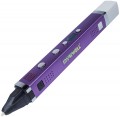Min thread diameter
The smallest diameter of polymer thread with which the pen can operate effectively; with a smaller thickness, the device will not be able to properly pass the material through the feeder. Usually, this diameter also corresponds to the regular thread diameter the device is designed for.
The most popular option for modern 3D pens is 1.75 mm; occasionally other values barely found — for example, some "heavyweight" high-performance models are designed for 3 mm threads.
Nozzle Diameter
The diameter of the nozzle provided in the pen.
The larger the nozzle, the thicker the lines produced by the pen will be (ceteris paribus; the actual thickness of the lines will also depend on the type of plastic and the adjusted temperature). In the thinnest models, the nozzle diameter is less than 0.5 mm, in the thickest models it is about 0.9 mm. Most modern 3D pens have nozzles in the range of 0.6 – 0.7 mm — this value is considered the most versatile and convenient for practical use.
Print Speed
The material feed rate provided by the pen. The higher this speed, the faster you can work with this model; on the other hand, the rapid supply of material requires increased accuracy and serious skills. The maximum value of this parameter in modern 3D pens is about 40 mm/s. Models with adjusted speed is also available (see below); for them, usually, the highest speed of operation is given in the specs.
Number of Speeds
The number of fixed speed settings provided in the pen. This spec is specified only if there is more than one such setting.
The speed control allows you to adjust the mode of operation to the circumstances: for example, a low speed will be convenient for fine work, and a high speed is so for large elements. And the more speed settings there are in the pen, the wider the choice for the user to configure the device more accurately. In the most advanced models, the number of speeds can reach eight.
Note that the speed adjust can be not only stepwise, but also smooth (see above).
USB powered
The pen is powered by a standard USB connector. Such devices are as versatile as possible in connectivity: they can be powered via a PC, a portable device like a laptop or tablet, an external power bank, a USB wall charger or car charger.
Display
The availability of a
built-in display. Usually, these are the simplest single-colour screens that display the basic operating parameters — speed and/or temperature. However, even such a display makes the pen more convenient and allows you to get important information about its operation.
Tip Material
The material of the pen tip.
— Ceramics. Usually, high-durability varieties of ceramics are used in 3D pens, which also have low thermal conductivity. The latter has a positive effect on the quality of work, and also reduces the risk of getting burned. Theoretically, ceramic is a fairly brittle material, but practically, to damage such a tip, a very strong impact is needed, and the plastic body of the pen is more likely to crack than the ceramic nozzle. Thereby, most of the modern 3D pens use ceramics.
— Metal. Metal tips are considered more reliable and impact resistant than ceramic ones, and are somewhat cheaper. However, in fact, these differences are usually not noticeable. But the thermal conductivity of metal is significantly higher than that of ceramics, which is why such a tip heats up quite strongly during operation and requires additional care. Thereby, this material is much less common than ceramics.
Country of brand origin
The country of origin indicated in the specifications of the device. Note that this is far from necessarily the place of actual manufacturing: frequently the “homeland” of the brand or the location of the manufacturer’s HQ is indicated as the country of origin of products. Additionally, giving the importance to this parameter, it should be taken into account that many “national” stereotypes are unfounded: in the modern world, the quality of a product depends not so much on its country of origin, but on the price category and the overall reputation of the manufacturer. So, paying attention to the country of origin makes sense only if you fundamentally want (or do not want) to support a brand from a certain country.
